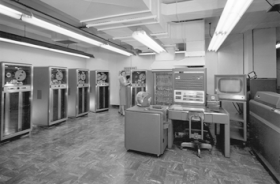


The IBM 704 is the model name of a large digital mainframe computer introduced by IBM in 1954. Designed by John Backus and Gene Amdahl, it was the first mass-produced computer with hardware for floating-point arithmetic.[1][2] The IBM 704 Manual of operation states:[3]
The type 704 Electronic Data-Processing Machine is a large-scale, high-speed electronic calculator controlled by an internally stored program of the single address type.
The 704 at that time was thus regarded as "pretty much the only computer that could handle complex math".[4] The 704 was a significant improvement over the earlier IBM 701 in terms of architecture and implementation. Like the 701, the 704 used vacuum-tube logic circuitry, but increased the instruction size from 18 bits to 36 bits, the same as the memory's word size. Changes from the 701 include the use of magnetic-core memory instead of Williams tubes, floating-point arithmetic instructions, 15-bit addressing and the addition of three index registers. To support these new features, the instructions were expanded to use the full 36-bit word. The new instruction set, which is not compatible with the 701, became the base for the "scientific architecture" subclass of the IBM 700/7000 series computers.
The 704 could execute up to 12,000 floating-point additions per second.[2] IBM produced 123 type 704 systems between 1955 and 1960.[5]
- ^ "The IBM 704". columbia.edu. Columbia University. February 2001. Retrieved September 20, 2024.
- ^ a b "704 Data Processing System". IBM Archives – Exhibits – IBM Mainframes – Mainframes reference room – Mainframes product profiles. IBM. 23 January 2003. Archived from the original on January 14, 2005. Retrieved 2016-08-18.
- ^ "IBM Electronic Data-Processing Machines TYPE 704" (PDF). IBM 704 Manual of Operation. International Business Machines Corporation. 1955. Retrieved 2017-12-28.
- ^ Pesce, Mark (26 Feb 2015). "Assemblers were once people: My aunt did it for NASA". Software – Developer. The Register. Retrieved 2016-08-18.
- ^ "History of IBM Timeline". IBM. 23 January 2003. Retrieved 2019-07-04.